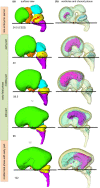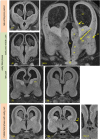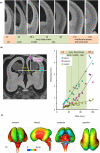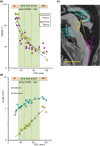Morphology and morphometry of the human early foetal brain: A three-dimensional analysis
- PMID: 33754346
- PMCID: PMC8273585
- DOI: 10.1111/joa.13433
Morphology and morphometry of the human early foetal brain: A three-dimensional analysis
Abstract
Morphometric analyses in the early foetal phase (9-13 postconceptional week) are critical for evaluating normal brain growth. In this study, we assessed sequential morphological and morphometric changes in the foetal brain during this period using high-resolution T1-weighted magnetic resonance imaging (MRI) scans from 21 samples preserved at Kyoto University. MRI sectional views (coronal, mid-sagittal, and horizontal sections) and 3D reconstructions of the whole brain revealed sequential changes in its external morphology and internal structures. The cerebrum's gross external view, lateral ventricle and choroid plexus, cerebral wall, basal ganglia and thalamus, and corpus callosum were assessed. The development of the cerebral cortex, white matter microstructure, and basal ganglia can be well-characterized using MRI scans. The insula became apparent and deeply impressed as brain growth progressed. A thick, densely packed cellular ventricular/subventricular zone and ganglionic eminence became apparent at high signal intensity. We detected the emergence of important landmarks which may be candidates in the subdivision processes during the early foetal period; the corpus callosum was first detected in the sample with crown-rump length (CRL) 62 mm. A primary sulcus on the medial part of the cortex (cingulate sulcus) was observed in the sample with CRL 114 mm. In the cerebellum, the hemispheres, posterolateral fissure, union of the cerebellar halves, and definition of the vermis were observed in the sample with CRL 43.5 mm, alongside the appearance of a primary fissure in the sample with CRL 56 mm and the prepyramidal fissure in the sample with CRL 75 mm. The volumetric, linear, and angle measurements revealed the comprehensive and regional development, growth, and differentiation of brain structures during the early foetal phase. The early foetal period was neither morphologically nor morphometrically uniform. The cerebral proportion (length/height) and the angle of cerebrum to the standard line at the lateral view of the cerebrum, which may reflect the growth and C-shape formation of the cerebrum, may be a candidate for subdividing the early foetal period. Future precise analyses must establish a staging system for the brain during the early foetal period. This study provides insights into brain structure, allowing for a correlation with functional maturation and facilitating the early detection of brain damage and abnormal development.
Keywords: T1-weighted magnetic resonance imaging; early foetal phase; foetal brain development; three-dimensional analysis.
© 2021 Anatomical Society.
Conflict of interest statement
There are no conflicts of interest to declare.
Figures












Similar articles
-
Early development of the cortical layers in the human brain.J Anat. 2021 Nov;239(5):1039-1049. doi: 10.1111/joa.13488. Epub 2021 Jun 17. J Anat. 2021. PMID: 34142368 Free PMC article.
-
MRI-based morphometric characterizations of sexual dimorphism of the cerebrum of ferrets (Mustela putorius).Neuroimage. 2013 Dec;83:294-306. doi: 10.1016/j.neuroimage.2013.06.024. Epub 2013 Jun 14. Neuroimage. 2013. PMID: 23770407
-
Three-dimensional morphogenesis of the human diaphragm during the late embryonic and early fetal period: Analysis using T1-weighted and diffusion tensor imaging.J Anat. 2023 Feb;242(2):174-190. doi: 10.1111/joa.13760. Epub 2022 Sep 2. J Anat. 2023. PMID: 36053545 Free PMC article.
-
In vitro MRI of brain development.Eur J Radiol. 2006 Feb;57(2):187-98. doi: 10.1016/j.ejrad.2005.11.019. Epub 2006 Jan 24. Eur J Radiol. 2006. PMID: 16439088 Review.
-
Insights from in vitro fetal magnetic resonance imaging of cerebral development.Semin Perinatol. 2009 Aug;33(4):220-33. doi: 10.1053/j.semperi.2009.04.003. Semin Perinatol. 2009. PMID: 19631083 Review.
Cited by
-
Morphometry of the Human Ventral Germinal Matrix during Fetal Development.Bull Exp Biol Med. 2025 Mar;178(5):675-680. doi: 10.1007/s10517-025-06396-w. Epub 2025 Apr 29. Bull Exp Biol Med. 2025. PMID: 40299125
-
Early development of the cortical layers in the human brain.J Anat. 2021 Nov;239(5):1039-1049. doi: 10.1111/joa.13488. Epub 2021 Jun 17. J Anat. 2021. PMID: 34142368 Free PMC article.
-
Quantification of Intracranial Structures Volume in Fetuses Using 3-D Volumetric MRI: Normal Values at 19 to 37 Weeks' Gestation.Front Neurosci. 2022 May 12;16:886083. doi: 10.3389/fnins.2022.886083. eCollection 2022. Front Neurosci. 2022. PMID: 35645723 Free PMC article.
References
-
- Bayer, S. & Altman, J. (2006) The human brain during the late first trimester. Boca Raton, FL; London: CRC; Taylor & Francis distributor, 592 pp.
-
- Blaas, H.G. (1999) The embryonic examination. Ultrasound studies on the development of the human embryo. PhD thesis. 10.13140/RG.2.1.5176.6642 - DOI
-
- Blaas, H.G. , Eik‐Nes, S.H. , Berg, S. & Torp, H. (1998) In‐vivo three‐dimensional ultrasound reconstructions of embryos and early fetuses. Lancet, 352, 1182–1186. - PubMed
-
- Boonstra, H. , Oosterhuis, J. , Oosterhuis, A. & Fleuren, G. (1983) Cervical tissue shrinkage by formaldehyde fixation, paraffin wax embedding, section cutting and mounting. Virchows Archiv A Pathological Anatomy and Histopathology, 402, 195–201. - PubMed
-
- Desmond, M.E. & O'Rahilly, R. (1981) The growth of the human brain during the embryonic period proper. 1. Linear axes. Anatomy and Embryology, 162, 137–151. - PubMed
Publication types
MeSH terms
LinkOut - more resources
Full Text Sources
Other Literature Sources

